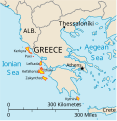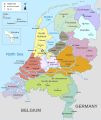Portal:Islands
The Islands Portal
This is a list of the lists of islands in the world grouped by country, by continent, by body of water, and by other classifications. For rank-order lists, see the other lists of islands below. (Full article...)
Selected article –
Olkhon (Russian: Ольхо́н, also transliterated as Olchon; Buryat: Ойхон, Oikhon) is the third-largest lake island in the world. It is by far the largest island in Lake Baikal in eastern Siberia, with an area of 730 km2 (280 sq mi). Structurally, it constitutes the southwestern margin of the Academician Ridge. The island measures 71.5 km (44.4 mi) in length and 20.8 km (12.9 mi) in width.
There are two versions regarding the origin of the name of the island and both are derived from the language of the Buryats, the indigenous people of Olkhon. The first is that the island's name comes from the word oyhon – “woody”, and the second is that it comes from olhan – “dry”. It is still debated which of the two is the actual origin of the name Olkhon as both words describe the island perfectly. Much of the island is still covered by forests and the amount of precipitation is extremely low – about 240 mm (9.4 in) per year. (Full article...)
Selected cuisines, dishes and foods –

Related articles
- List articles
- List of islands
- List of islands by area
- List of islands by highest point
- List of islands by name
- List of islands by population
- List of islands by population density
- List of archipelagos
- List of archipelagos by number of islands
- List of artificial islands
- List of divided islands
- List of fictional islands
- List of island countries
- List of islands in lakes
- List of islands named after people
- List of islands of the European Union
- List of private islands
Selected image –
Did you know –

- ... that Mauatua married the Bounty mutineer Fletcher Christian and ensured women on Pitcairn were given the vote?
- ... that bshp's cover of "Kissing You" was streamed more than 3,000,000 times on Spotify after it appeared on Love Island?
- ... that in 1999 two necklaces were repatriated to the Cook Islands National Museum from a museum in Angus, Scotland?
- ... that after decades of being a central hub for river dredging operations, Stony Island's population was reduced to a caretaker and his two dogs?
- ... that New Zealand's Native Island hosted a colony of Samoyeds and huskies used in both the Southern Cross and Nimrod expeditions to the South Pole?
- ... that artificial islands were deployed in Hicklin Lake in an unsuccessful attempt to stop eutrophication?
General images –
Related portals
WikiProjects
Topics
Categories
Associated Wikimedia
The following Wikimedia Foundation sister projects provide more on this subject:
-
Commons
Free media repository -
Wikibooks
Free textbooks and manuals -
Wikidata
Free knowledge base -
Wikinews
Free-content news -
Wikiquote
Collection of quotations -
Wikisource
Free-content library -
Wikiversity
Free learning tools -
Wikivoyage
Free travel guide -
Wiktionary
Dictionary and thesaurus
Things to do
 |
Here are some tasks awaiting attention:
|
Web resources
- Listing of islands from the United Nations Island Directory

































![Image 30The Shamanka Шаманка [ru], a holy rock in Shamanism and one of the 9 most holy places in Asia, on the westcoast of Olkhon (from List of islands of Russia)](http://upload.wikimedia.org/wikipedia/commons/thumb/2/27/Shaman_Kamen.jpg/120px-Shaman_Kamen.jpg)


































































